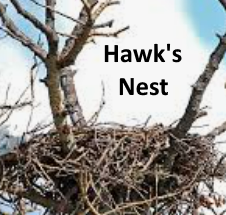Hummingbird Secrets: Why They Prefer Hawk Nests
Why Hummingbirds Nest Near Hawks: An Unexpected Alliance
Hummingbirds, with their vibrant plumage and rapid wing beats, are often seen as delicate creatures of the garden. Interestingly, these tiny birds have developed a unique survival strategy that involves nesting close to the nests of much larger and seemingly more dangerous birds: hawks. This surprising behavior raises intriguing questions about the interactions between different species in nature.
An Unlikely Neighborhood
At first glance, it seems counterintuitive that a hummingbird would choose to live near a hawk, given the predatory nature of the latter. However, this proximity is a strategic decision by the hummingbirds, rooted in the benefits of safety and reduced predation. Hawks, like most raptors, tend to dominate their territories and are very protective of their nesting area. They chase away many potential predators that might pose a threat to their young or disrupt their peace.
The Benefits of a Protective Umbrella
For hummingbirds, nesting near a hawk means fewer encounters with common nest raiders such as jays, crows, and squirrels. These animals, which often prey on the eggs and young of smaller bird species, are typically intimidated by hawks and steer clear of their vicinity. Essentially, hummingbirds benefit from a protective umbrella effect, whereby the presence of a powerful predator ensures a safer environment for raising their own young.
A Case of Indirect Mutualism
This arrangement is a prime example of an ecological interaction known as indirect mutualism. Here, the hummingbirds gain increased survival odds for their offspring, while the hawks remain largely unaffected by the presence of their tiny neighbors. However, it’s possible that hawks could indirectly benefit from the arrangement as well. The activity of smaller birds around their nest site might help to camouflage and draw attention away from the hawk’s own nest, reducing the risk of predation from other large predatory birds.
Considerations and Consequences
Furthermore, the survival strategy of hummingbirds can influence their nesting habits and choices significantly. Typically, hummingbirds might select nesting sites that offer optimal conditions for their tiny, delicate nests, which are often a masterpiece of spider silk and plant material. By choosing to nest near hawks, they might compromise on other factors, such as the abundance of food resources nearby or the ideal microclimate. However, the trade-off for increased safety appears to be a worthwhile strategy, given the harsh realities of nature’s food chain.
The Intricacies of Bird Interactions
The decision to nest near a predator might seem a high-risk strategy, but it speaks volumes about the intricate and often surprising ways in which different species interact in the wild. These interactions are crucial for the survival of many species, influencing breeding choices and strategies in often unforeseen ways. For ornithologists and bird-watchers alike, such dynamics offer fascinating insights into the adaptability and ingenuity of birds like the hummingbird.
As researchers continue to observe and study these interactions, more light is shed on the complexity of ecosystems and the interconnectedness of different species within them. The hummingbird’s choice of nesting site is just one of many examples of how animals adapt behaviors in response to their predators and the broader environmental challenges they face.
A Closer Look at Nature’s Wonders
Understanding why hummingbirds nest near hawks opens a window into the broader theme of survival in the animal kingdom. It shows us that survival often depends on making unlikely alliances and taking calculated risks. Nature is full of such remarkable survival strategies, and each one has evolved to suit the specific needs and challenges of the species involved.
For nature enthusiasts and wildlife researchers, these insights not only deepen our understanding of animal behavior but also remind us of the resilience and complexity inherent in the natural world. Observing and studying these behaviors encourages a greater respect and appreciation for the delicate balances within ecosystems, highlighting the importance of conserving diverse habitats that support such rich and intricate biological interactions.
In conclusion, the hummingbird’s practice of nesting near hawks serves as a vivid example of how the quest for survival can lead to unexpected and innovative ecological strategies. Such strategies underscore the brilliance of evolution and the continuous dance of adaptation and survival that plays out across the globe’s ecosystems.






